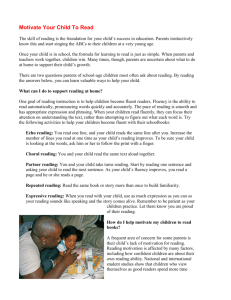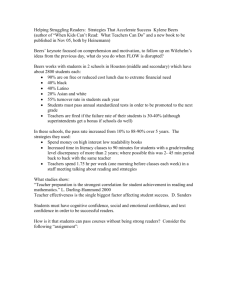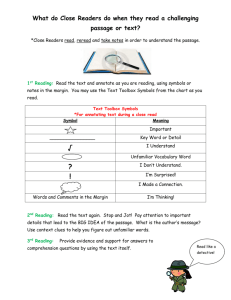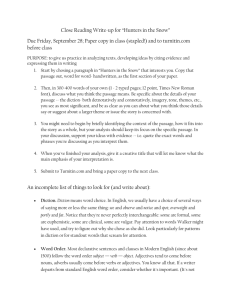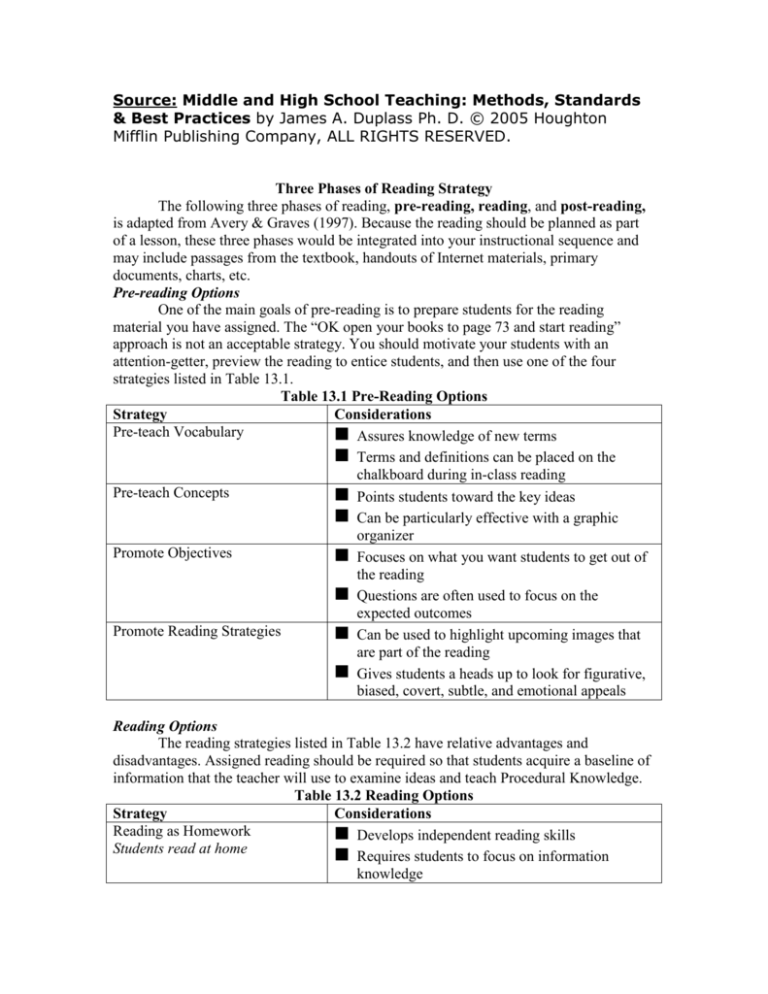
Source: Middle and High School Teaching: Methods, Standards
& Best Practices by James A. Duplass Ph. D. © 2005 Houghton
Mifflin Publishing Company, ALL RIGHTS RESERVED.
Three Phases of Reading Strategy
The following three phases of reading, pre-reading, reading, and post-reading,
is adapted from Avery & Graves (1997). Because the reading should be planned as part
of a lesson, these three phases would be integrated into your instructional sequence and
may include passages from the textbook, handouts of Internet materials, primary
documents, charts, etc.
Pre-reading Options
One of the main goals of pre-reading is to prepare students for the reading
material you have assigned. The “OK open your books to page 73 and start reading”
approach is not an acceptable strategy. You should motivate your students with an
attention-getter, preview the reading to entice students, and then use one of the four
strategies listed in Table 13.1.
Table 13.1 Pre-Reading Options
Strategy
Considerations
Pre-teach Vocabulary
Assures knowledge of new terms
Terms and definitions can be placed on the
chalkboard during in-class reading
Pre-teach Concepts
Points students toward the key ideas
Can be particularly effective with a graphic
organizer
Promote Objectives
Focuses on what you want students to get out of
the reading
Questions are often used to focus on the
expected outcomes
Promote Reading Strategies
Can be used to highlight upcoming images that
are part of the reading
Gives students a heads up to look for figurative,
biased, covert, subtle, and emotional appeals
Reading Options
The reading strategies listed in Table 13.2 have relative advantages and
disadvantages. Assigned reading should be required so that students acquire a baseline of
information that the teacher will use to examine ideas and teach Procedural Knowledge.
Table 13.2 Reading Options
Strategy
Considerations
Reading as Homework
Develops independent reading skills
Students read at home
Requires students to focus on information
knowledge
Reading Aloud by the Teacher
Teacher reads the content
Independent Silent Reading
Students read an assigned
passage in silence
Rotational or Round-Robin
Reading
Each student reads a paragraph
or passage aloud
Reading in Groups
Each student reads a paragraph
or passage aloud in small groups
Is effective only if the teacher has evaluation
following the reading, either as bell work or as
an assessment prior to instruction
The reading material must be at the appropriate
reading level.
Models the joy and practice of reading
Should include teacher sharing of Metacognition.
The most straightforward approach to modeling
Metacognition is for the teacher to articulate his
or her own thinking while reading a passage of
text. This “talking out loud” approach explicitly
teaches the underlying thinking process that one
should use when reading. Failure to model
Metacognitive processes can result in students’
failure to understand and acquire the full set of
skills that are needed to empower them to be
lifelong learners.
Provides a model of correct pronunciation and
how “good” reading sounds.
Students do not practice reading, they just listen.
Can be boring, so use short interesting pieces.
Reading takes place in class, and the teacher can
circulate to provide individual assistance to
students with weaker reading skills.
The teacher does not know who is actually
reading the material or students’ level of
comprehension without an evaluation, so it
should be paired with an activity to monitor
comprehension.
This strategy is the least efficient approach
Weaker readers often feel embarrassed; when
weaker readers’ turns comes up, other students
may exhibit displeasure
Stronger readers are bored
Better to have reading in supervised small
groups
Heterogeneous groups of four allow everyone to
read multiple paragraphs.
Stronger readers can be assigned to help weaker
readers, or assign roles like reader, questioner,
note-taker, etc.
Weaker readers are not as inhibited in the
smaller groups.
Student-Teacher Shared Reading
Teacher begins to read and then
asks students to read;
Teacher reads and ask questions
to ensure comprehension; or
Teacher assigns short sections to
be read independently and guides
their discussion.
Choral Reading
All students read in unison.
Students can reflect and share ideas for
reinforcement and uniformity of understanding
Teacher must circulate among groups.
This approach has similar shortcomings to
rotational or round-robin reading, if not carefully
choreographed.
Questions can be interspersed to keep everyone
attentive and to assure a baseline of content
knowledge.
It allows weaker readers to follow along in a
large group with anonymity and little
apprehension, but the teacher cannot access
individual reading ability and participation.
Often students do not participate and their minds
wonder.
Post-reading Options
After every reading, there needs to be a post-reading activity (see Table 13.3) in
which the teacher further develops some of the ideas to reinforce the reading. Postreading usually precedes the instruction in which the teacher develops new but related
Big Ideas or Procedural Knowledge and introduces new, related Information Knowledge.
In many cases, post-reading become a part of the content presentation.
Table 13.3 Post-Reading Options
Strategy
Considerations
Debriefing
Debriefing should not be limited only to the facts, but should
also be elevated to the concept level. Teacher-centered
probing of students allows the students to summarize,
synthesize, and report their construction of the information.
The teacher can engage students with additional concepts.
Summarizing
Summarizing is not as effective as debriefing, and students
will learn not to read because they anticipate that the teacher
is going to summarize.
Discussion
Students in groups of four or five should focus on discussion
questions provided by the teacher that require predicting or
analyzing, and the teacher should circulate among the
groups.
Simulation
Students create a simulation (role-playing) to demonstrate
their understanding of the reading: Requires a debriefing by
the teacher after each skit.
Project
Students would be given a project, writing assignment,
graphic organizer, or other project to demonstrate or apply
their knowledge: Requires a debriefing by the teacher upon
completion of the task.
Basal Worksheets
Many textbook companies provide worksheets to accompany
social studies textbooks. These tend to be fact-based and
evaluate only lower-level learning.



